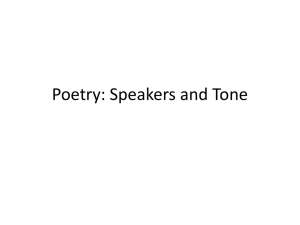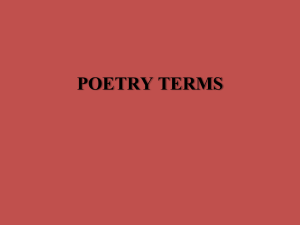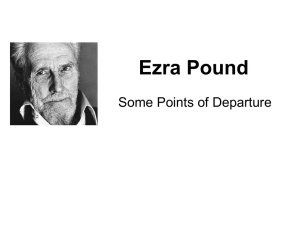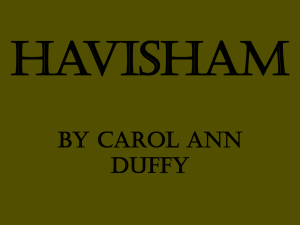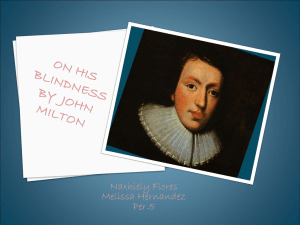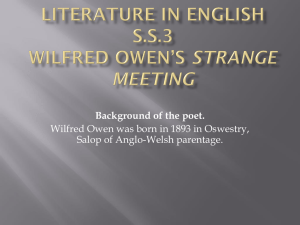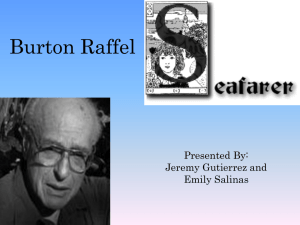Havisham - Mrs Ruxton
advertisement
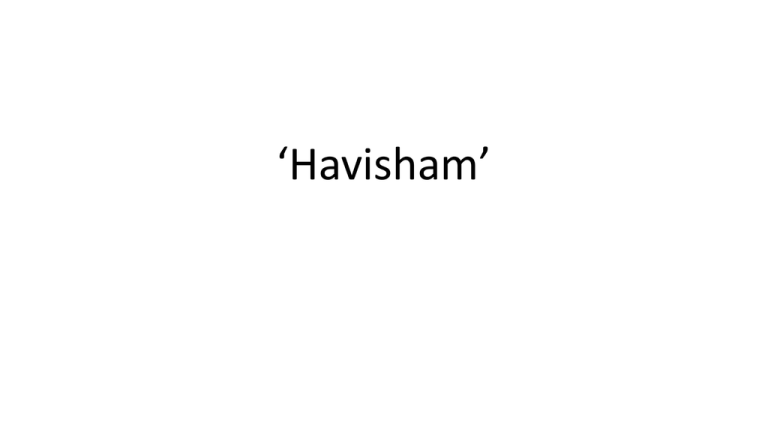
‘Havisham’ Dramatic Monologue Dramatic monologue refers to a type of poetry. These poems are dramatic in the sense that they have a theatrical quality; that is, the poem is meant to be read to an audience. A monologue means that these are the words of one solitary speaker with no dialogue coming from any other characters. Think of one person standing alone on a stage speaking to an audience. Dramatic Monologue Poets write dramatic monologues to express a point of view through the words of a character. However, the tricky part is that often the opinions stated by that character are not the same as the views of the poet. Most of the time, the speaker is trying to convince someone of something, and may or may not be telling the whole truth. Sometimes what the speaker doesn't say is just as revealing and interesting as what he or she does say in the poem. Dramatic Monologue The speaker has a listener within the poem, but we too are his / her listener, and we learn about the speaker’s character from what the speaker says. In fact, the speaker may unintentionally reveal certain aspects of his / her character – often unsavoury. Each dramatic monologue should display: 1) a speaker 2) an identified audience 3) an occasion 4) an interplay between speaker and audience, which takes place in the present 5) revelation of character Dramatic Monologue Duffy’s monologues typically consist of an uninterrupted narrative spoken by a single character to a specific audience. It is important to remember that the speaker is not the poet herself, but rather a persona created by Duffy. Duffy creates a living, breathing human being (often the wife of a famous historical person) with a complex personal history and view of the world. ‘Havisham’ • The speaker in the poem is the character of Miss Havisham, taken from the Dickens novel ‘Great Expectations’. • In the novel, she is deserted at the altar on her wedding day by her husband-to-be. • She is completely devastated and never recovers. • She continues to wear her decaying wedding dress, adopts a daughter and brings her up teaching her to hate all men. ‘Havisham’ Pip is a poor orphan who lives with his sister. He is not treated well as the family is struggling. Pip gets invited unexpectedly to the house of a rich old woman in the village, Miss Havisham. We are going to read an extract from the novel describing Pip’s first meeting with Miss Havisham. The first encounter: This was very uncomfortable, and I was half afraid. However, the only thing to be done being to knock at the door, I knocked, and was told from within to enter. I entered, therefore, and found myself in a pretty large room, well lighted with wax candles. No glimpse of daylight was to be seen in it. It was a dressing-room, as I supposed from the furniture, though much of it was of forms and uses then quite unknown to me. But prominent in it was a draped table with a gilded looking-glass, and that I made out at first sight to be a fine lady's dressing-table. Whether I should have made out this object so soon, if there had been no fine lady sitting at it, I cannot say. In an arm-chair, with an elbow resting on the table and her head leaning on that hand, sat the strangest lady I have ever seen, or shall ever see. She was dressed in rich materials - satins, and lace, and silks - all of white. Her shoes were white. And she had a long white veil dependent from her hair, and she had bridal flowers in her hair, but her hair was white. Some bright jewels sparkled on her neck and on her hands, and some other jewels lay sparkling on the table. Dresses, less splendid than the dress she wore, and half-packed trunks, were scattered about. She had not quite finished dressing, for she had but one shoe on - the other was on the table near her hand - her veil was but half arranged, her watch and chain were not put on, and some lace for her bosom lay with those trinkets, and with her handkerchief, and gloves, and some flowers, and a prayer-book, all confusedly heaped about the looking-glass. It was not in the first few moments that I saw all these things, though I saw more of them in the first moments than might be supposed. But, I saw that everything within my view which ought to be white, had been white long ago, and had lost its lustre, and was faded and yellow. I saw that the bride within the bridal dress had withered like the dress, and like the flowers, and had no brightness left but the brightness of her sunken eyes. I saw that the dress had been put upon the rounded figure of a young woman, and that the figure upon which it now hung loose, had shrunk to skin and bone. Once, I had been taken to see some ghastly waxwork at the Fair, representing I know not what impossible personage lying in state. Once, I had been taken to one of our old marsh churches to see a skeleton in the ashes of a rich dress, that had been dug out of a vault under the church pavement. Now, waxwork and skeleton seemed to have dark eyes that moved and looked at me. I should have cried out, if I could. "Who is it?" said the lady at the table. "Pip, ma'am.” "Pip?” "Mr. Pumblechook's boy, ma'am. Come - to play." "Come nearer; let me look at you. Come close.” It was when I stood before her, avoiding her eyes, that I took note of the surrounding objects in detail, and saw that her watch had stopped at twenty minutes to nine, and that a clock in the room had stopped at twenty minutes to nine. "Look at me," said Miss Havisham. "You are not afraid of a woman who has never seen the sun since you were born?” I regret to state that I was not afraid of telling the enormous lie comprehended in the answer "No." "Do you know what I touch here?" she said, laying her hands, one upon the other, on her left side. "Yes, ma'am." (It made me think of the young man.) "What do I touch?" "Your heart." "Broken!" Miss Havisham’s only companion is Estella, her adopted daughter. Estella is beautiful, and Pip develops a strong infatuation, an infatuation that turns into love as he grows older. But it is unrequited love, as Miss Havisham has made it her dark life's project to raise Estella as a cruel-hearted girl who will break men's hearts, satisfying Miss Havisham's own desire to spurn love. Now you are going to read the poem Havisham Beloved sweetheart bastard. Not a day since then I haven’t wished him dead. Prayed for it so hard I’ve dark green pebbles for eyes, ropes on the back of my hands I could strangle with. 5 Spinster. I stink and remember. Whole days in bed cawing Nooooo at the wall; the dress yellowing, trembling if I open the wardrobe; the slewed mirror, full-length, her, myself, who did this to me? Puce curses that are sounds not words. 10 Some nights better, the lost body over me, my fluent tongue in its mouth in its ear then down till I suddenly bite awake. Love’s hate behind a white veil; a red balloon bursting in my face. Bang. I stabbed at a wedding cake. 15 Give me a male corpse for a long slow honeymoon. Don’t think it’s only the heart that b-b-b-breaks. Form and structure The poem is written in four unrhymed stanzas. Duffy has said that she enjoys the way stanzas help her to concentrate and fix her ideas more effectively, and has described them as being almost like mini-canvases. The lack of rhyme and the presence of enjambment help to create a more defined voice in the poem. However, while this can often produce a more natural, realistic speech pattern, in this case it has the opposite effect: Havisham’s voice is choppy and stilted, which emphasises the lack of order and structure to her thoughts. Similarly, although at first glance the poem looks fairly regular, there is no fixed meter. This, and the occasional slightly off-kilter half rhymes and assonance, help to reinforce this lack of logic and the erosion of the speaker’s psyche. You are now going to discuss questions on the poem in groups and take notes of your ideas. Try to answer them as fully as possible, and be ready to share your ideas with the class. Feedback Group Discussion Questions Title 1. Why does the poet omit Miss Havisham's title and refer to her by her surname only? Verse 1 2. What does the oxymoron in line one reveal about her feelings? 3. Explain the image ‘dark green pebbles for eyes.’ 4. Explain the image ‘ropes on the back of my hands.’ Verse 2 5. Why does the poet write “spinster” on its own? What does Miss Havisham think about this word and its relevance to her? 6. What is her attitude to the fact she is unmarried? 7. Comment on the use of the word ‘stink’. 8. Comment on the use of the word ‘cawing’. 9. What is the effect of “Nooooo”? Why is the word written in this way? 10. Comment on the last line – can you explain the structure? Group Discussion Questions Verse 3 11. What connotations are there for ‘puce’ (dark red)? 12. What is the speaker describing in lines 10-13? 13. What might this reveal? Verse 4 14. What could the ‘red balloon’ symbolise and what is the significance of it bursting? 15. Comment on the use of onomatopoeia. 16. What is the tone of this verse? 17. What is the effect of “b-b-breaks” in the final line? Why is repetition used in this way? Group Discussion Questions The whole poem 18. The poet is effectively exploring a number of themes in this poem. What do you think they are? 19. How far does the poet want us to sympathise with Miss Havisham? 20. Does the reader have to know about Great Expectations to understand the poem? 21. Does Miss Havisham have a fair view of men? What do you think of her view of being an unmarried woman? 22. Perhaps the most important part of the poem is the question “who did this / to me?” How far does the poem show that Miss Havisham is responsible for her own misery, and how far does it support her feelings of self-pity and her desire for revenge? You are now going to annotate a copy of the poem. You don’t have to write down every single word, but you must take detailed notes for everything that is on the slides. Make sure your writing is not too big so that you can fit in all the annotations. You will use these notes for exam revision, so make them good! Themes The key theme in this poem is the corrosive nature of hatred on the human psyche. In giving Miss Havisham a voice outside of Dickens’ novel, the poet is able to crystallise perfectly how the single event of being jilted can completely shatter and destroy a human being, and erode any love or compassion that could once be felt. The mood throughout is bitter and caustic as Duffy clearly conveys how love can quickly be replaced with hatred and violence. The wedding imagery, the cake, the dress and the honeymoon, are all used to reinforce how quickly experiences and events associated with joy can be soured and become toxic symbols to feed and nourish hatred instead of love. The title of the poem, her unmarried surname, reveals her self- loathing and bitterness at being denied the epithet of Mrs and being forced to live the remainder of her life as a spinster. ‘Havisham’ Reveals without ambiguity the focus of the speaker’s hatred and emphasises the expletive Alliteration of `b’ and `p’ sound suggests ANGER Oxymoronic minor sentence shows combination of feelings – love and hate Heavy emphasis here perhaps indicating her negative / aggressive feelings are now the dominant ones Note the lack of exclamation mark – suggests she is serious and seemingly no longer angry? Beloved sweetheart bastard. Not a day since then I haven’t wished him dead. Prayed for it Enjambment – run on lines i.e. the wedding day The words are Religious reference – ironic – almost being spat usually we pray for positive so hard I’ve dark green pebbles for eyes, out, helping to things create the caustic, bitter ropes on the back of my hands I could strangle with. tone that runs through the poem Highlights the intensity of her vengeful desires. This entire stanza is a kind of curse, detailing the extent to which she wishes her former lover dead through the all-consuming nature of her hatred. She has prayed so earnestly for his death, with her eyes tightly shut and her hands clasped together, that her eyes have become dark green pebbles and the veins on the back of her hands protrude like ropes. She is literally stuck in time, paralysed as a ridiculous parody or imitation of a bride whose love has been rejected by her fiancé. Metaphor represents her jealousy and bitterness Beloved sweetheart bastard. Not a day since then I haven’t wished him dead. Prayed for it so hard I’ve dark green pebbles for eyes, Hardened emotions? Dark for her evil thoughts of revenge? Green link with jealousy? Lack of transparency – might highlight the way she conceals her true feelings ropes on the back of my hands I could strangle with. Duffy clearly exposes the terrible, corrosive effects of such an experience on the human psyche. Metaphor used to emphasise the strength of her hands. Image of a pebble – suggests hardness and cruelty Theme of violence in the poem Metaphor represents her ageing, as well as the years spent ‘wringing her hands’ with emotion / anger / nerves Negative spoken like a profanity or insult connotations One word sentence placed at start Denotes her of stanza so it stands out - this is bitterness what society sums her up as She sees her life as decay and memories Literally true because she has never washed since her wedding day? Or low self esteem? Spinster. I stink and remember. Whole days Observation of what she is now (literally) – and a suggestion of what was wrong (metaphorically) with her to be dumped? ‘Spinster’ is isolated in a sentence on its in bed cawing Nooooo at the wall; the dress own to Further emphasises emphasise Miss her isolation Havisham's own yellowing, trembling if I open the wardrobe; feelings of isolation in a society in which the slewed mirror, full-length, her, myself, who did this women were Avian (bird) terminology The cry of Makes her often defined by a crow New word (neologism) used to show how she sound like an their marital used to represent pain feels demeaned or creates animal, reveals status Emphasises primitive rejected by her lover who gothic the extent of rawness of emotions has flown the nest? imagery her anguish Double meaning – the dress trembles, as if waiting to be put back away (personification) OR she literally trembles when looking at her wedding dress. Perhaps she is frightened of looking in the mirror and seeing what she has become. As though it is someone else who has done this; she can’t believe that the woman in the mirror would do this. Split personality? Disturbed? Highlights Spinster. I stink and remember. Whole days how much time has passed; in bed cawing Nooooo at the wall; the dress imitates her emotional atrophy and yellowing, trembling if I open the wardrobe; reflects decay Violence She is unable to identify herself – ‘he’ made her an ‘object’ and she now fights to regain her sense of self the slewed mirror, full-length, her, myself, who did this Double meaning – past tense of ‘slay’ suggesting she has smashed the mirror in anger / also means drunk, suggesting she is unable to see her true reflection through the blur of alcohol The world that she once knew and felt she belonged to is now similarly unfamiliar and strange Sounds like she no longer recognises what she has become – she has been profoundly changed by rejection This stanza emphasises just how entirely out of place and alien she feels inhabiting her new persona as a spinster. In this stanza, the construction and order of the lines and words is deliberately jumbled and confused to emphasise the speaker’s irrationality and her muddled, tormented state of mind. Spinster. I stink and remember. Whole days in bed cawing Nooooo at the wall; the dress yellowing, trembling if I open the wardrobe; the slewed mirror, full-length, her, myself, who did this She presents herself as the victim - this was a wrong that was done to her and she is determined to exact revenge. The irony is that this quest and lust for vengeance is utterly self destructive and only exacerbates her pain. She asks who has made her this way Connotations? Dried blood? Disease? Synaesthesia, when one sense, in this case sight, is used to describe another, the sounds of the speaker’s curses Purplish - red to me? Puce curses that are sounds not words. Enjambment reinforces the continuation of Some nights better, the lost body over me, her suffering and conveys the idea of run my fluent tongue in its mouth in its ear away emotions and a lack of control. Evokes then down till I suddenly bite awake. Love’s a troubled, Abrupt change in restless mind? Suggests that at direction, a glimpse at night she is able to the softer side of the dream speaker Her hatred has left her almost mute, unable to articulate her emotions through language, and instead she can only vocalise her bitter anger through sounds not words (compare with line 6) References to sexual relationship with the man she might have married The dream continues and the love making is easy and poetic to me? Puce curses that are sounds not words. Some nights better, the lost body over me, my fluent tongue in its mouth in its ear Her sexual fantasy / dream reveals she cannot rid herself of her desire /affection which now torments her in the living nightmare of her waking existence In contrast to her ineptitude with language now, she recalls how when she could skilfully use her ‘fluent tongue’ to seduce her lover then down till I suddenly bite awake. Love’s …and therefore makes it easier for her to continue to hate him. This creates a sense of distance from him, while simultaneously depriving him of his humanity… She tries to make him the ‘object’ by using ‘its’ rather than ‘his’ Even here, though, the strength of her hatred continues to permeate and sour all of her most pleasant memories. Violence The act of violence is ‘sudden’ in the dream and the suddenness wakes her When she wakes the hatred and anger return to me? Puce curses that are sounds not words. Some nights better, the lost body over me, It also wakens us, the reader, to the viciousness of the dreamed attack my fluent tongue in its mouth in its ear then down till I suddenly bite awake. Love’s or, even more sinisterly, that she fantasises about inflicting pain on her lover by biting him ‘bite’ could also imply that she bites her tongue in her sleep, helping to explain her current inability to articulate herself… The use of the present tense in the verb ‘bite’ reminds us that, despite the passing of years, her anger and bitterness have not abated and are just as raw today as when she was first jilted This exposes There is something almost ‘Hate’ is the only just how possessive, distinctive about the emotion she is inextricably specific and enduring type of now able to feel linked these hate that is provoked through the two seemingly betrayal of love opposing hate behind a white veil; a red balloon bursting emotions are ‘Love’s hate’ - Use of oxymoron to show the unstable mixture of Havisham’s feelings in my face. Bang. I stabbed at a wedding-cake. Give me a male corpse for a long slow honeymoon. Don’t think it’s only the heart that b-b-b-breaks. Without it she would be utterly numb and so in many ways it is only by preserving and nurturing her loathing and hatred that she has a purpose to her life Triple meaning – 1) ‘white’ suggests innocence / virginity, 2) ‘white veil’ represents the wedding, 3) ‘veil’ is something that the speaker hides behind hate behind a white veil; a red balloon bursting in my face. Bang. I stabbed at a wedding-cake. She clearly identifies herself as the wronged, innocent party in this image, but she cannot maintain it for any length of time Immediate contrast - suggests celebrations that did not take place, ‘red’ suggests anger. Give me a male corpse for a long slow honeymoon. This is used to express her Don’t think it’s only the heart that b-b-b-breaks. Shows how fragile love can be Alliteratio n might symbolise her broken heart Alliteration of `b’ sound suggests ANGER… …and emphasises the suddenness and shock of this experience as her dreams were so abruptly and irrevocably shattered. embarrassment (the veil concealed this) This violent metaphor represents the speaker’s heart and the rage and hatred that now consumes her. She subverts our usual associations of the honeymoon with joy and happiness into something much more menacing Short sentence for effect – also represents the shock she experienced Violence One word sentence / onomatopoeia - emphasises power / suddenness of her realisation. hate behind a white veil; a red balloon bursting Subverts our usual happy associations of weddings ‘Long’ + ‘slow’ – into another violent image combination of - ‘stabbed at a weddingenjoyment and in my face. Bang. I stabbed at a wedding-cake. cake’ shows literally her torture anger and it Give me a male corpse for a long slow honeymoon. metaphorically shows her This command is opinion on marriage a morbid, macabre, erotic Don’t think it’s only the heart that b-b-b-breaks. As the cake lies there perverse decaying, it reminds us Sinister, dark imagery, reference to death links to idea that the request. She is that, like Miss Havisham, it ‘honeymoon’ would provide the long painful death she wants deeply too has never fulfilled its disturbed, purpose and, like her, the She would rather have him dead than have him vengeful and cake continues to stagnate reject her – shows how bitter and twisted she is malevolent. and atrophy This hatred and anger have consumed and destroyed every other aspect or facet of her personality so that she is now little more than an empty husk hate behind a white veil; a red balloon bursting in my face. Bang. I stabbed at a wedding-cake. Give me a male corpse for a long slow honeymoon. Don’t think it’s only the heart that b-b-b-breaks. She suggests that her life and her mind have broken as a result, not just her heart The last line is more poignant Sobbing and suggestion of violence – a veiled threat Stammered words to suggest a kind of emotional collapse Use of plosive ‘b’ in a stuttering style, suggests the is breaking down again and highlights her emotional and psychological fragility You are now going to work in groups to produce a poster on an aspect of the poem which will form part of a wall display. You will be asked to produce notes on one or more of the following aspects of the poem: What is the poem about? Who is the speaker? - are they dramatised (a character) Who is being spoken to or addressed? What is being spoken about? Theme(s) of the poem - what is it really about? Setting/culture - where’s the poem set? Which culture is it from/about? Where does the poem “get to” from start to end? ‘Havisham’ - MITSL Meaning Meaning, Imagery, Tone, Structure, Language Always link everything to meaning. Ask yourself how does this contribute to the meaning? Why has the poet used this technique? Structure Rhyme - is there a rhyme scheme? Couplets? Internal rhyme? Rhythm - how many syllables per line? Is it regular or free verse? Why are some different How would the poem be spoken? (angry, sad, nostalgic, bitter, humorous etc) lengths? Tone Language Stanzas - How many? How do they change? Is there a narrative? Lines - how many are their in each verse? Do some stand out? Enjambment - do the lines “run on” to the next line or stanza? End stopping - does each line finish at the end of a sentence? Form - does the poem have a shape to it? What kinds of words are used? Puns - a pun is a play on words - “Shear Class!” if Shearer scores. Connotation - associations that words have (as "stallion" connotes a certain kind of horse with certain sorts of uses)? Double meanings - “butts in” - putting bottoms in or interrupting. Ambiguity - is the word or phrase deliberately unclear? Could it mean opposite things or many different things?. Imagery Alliteration - the repeating of initial sounds. Assonance - is the term used for the repetition of vowel sounds within consecutive words as in, 'rags of green weed hung down...'. Metaphor - comparing two things by saying one is the other. Simile - comparing two things saying one is like or as the other. Personification - giving something non-human human qualities. Onomatopoeia - words that sound like the thing they describe. Repetition - does the poet repeat words or phrases? Word order - are the words in an unusual order – why? Adjectives - what are the key describing words? Key words and phrases - do any of the words or phrases stand out? Do they shock? Are the words “violent” or “sad” etc? Slang or unusual words and misspellings - Does the poet use slang or informal language? Are American words used? Intertextuality - does the poem reference another text? Style - does the poet copy another style? (Newspaper, play etc) Characters - if there are characters how do they speak? ‘Havisham’ - MITSL Meaning, Imagery, Tone, Structure, Language Meaning What is the poem about? Who is the speaker? - are they dramatised (a character) Who is being spoken to or addressed? What is being spoken about? Theme(s) of the poem - what is it really about? Setting/culture - where’s the poem set? Culture it is from/about? Where does the poem “get to” from start to end? ‘Havisham’ - MITSL Meaning, Imagery, Tone, Structure, Language Structure Rhyme - is there a rhyme scheme? Couplets? Internal rhyme? Rhythm - how many syllables per line? Is it regular or free verse? Why are some different lengths? Stanzas - How many? How do they change? Is there a narrative? Lines - how many are their in each verse? Do some stand out? Enjambment - do the lines “run on” to the next line or stanza? End stopping - does each line finish at the end of a sentence? Form - does the poem have a shape to it? ‘Havisham’ - MITSL Meaning, Imagery, Tone, Structure, Language Imagery Alliteration - the repeating of initial sounds. Assonance - is the term used for the repetition of vowel sounds within consecutive words as in, 'rags of green weed hung down...'. Metaphor - comparing two things by saying one is the other. Simile - comparing two things saying one is like or as the other. Personification - giving something non-human human qualities. Onomatopoeia - words that sound like the thing they describe. Repetition - does the poet repeat words or phrases? Language What kinds of words are used? Puns - a pun is a play on words - “Shear Class!” if Shearer scores. Connotation - associations that words have (as "stallion" connotes a certain kind of horse with certain sorts of uses)? Double meanings - “butts in” - putting bottoms in or interrupting. Ambiguity - is the word or phrase deliberately unclear? Could it mean opposite things or many different things?. Word order - are the words in an unusual order – why? Adjectives - what are the key describing words? Key words and phrases - do any of the words or phrases stand out? Do they shock? Are the words “violent” or “sad” etc? Slang or unusual words and misspellings - Does the poet use slang or informal language? Are American words used? Intertextuality - does the poem reference another text? Style - does the poet copy another style? (Newspaper, play etc) Characters - if there are characters how do they speak? ‘Havisham’ - MITSL Meaning, Imagery, Tone, Structure, Language Tone How would the poem be spoken? (angry, sad, nostalgic, bitter, humorous etc) ‘Havisham’ - MITSL Meaning, Imagery, Tone, Structure, Language Always link everything to meaning. Ask yourself how does this contributes to the meaning? Why has the poet used this technique?

